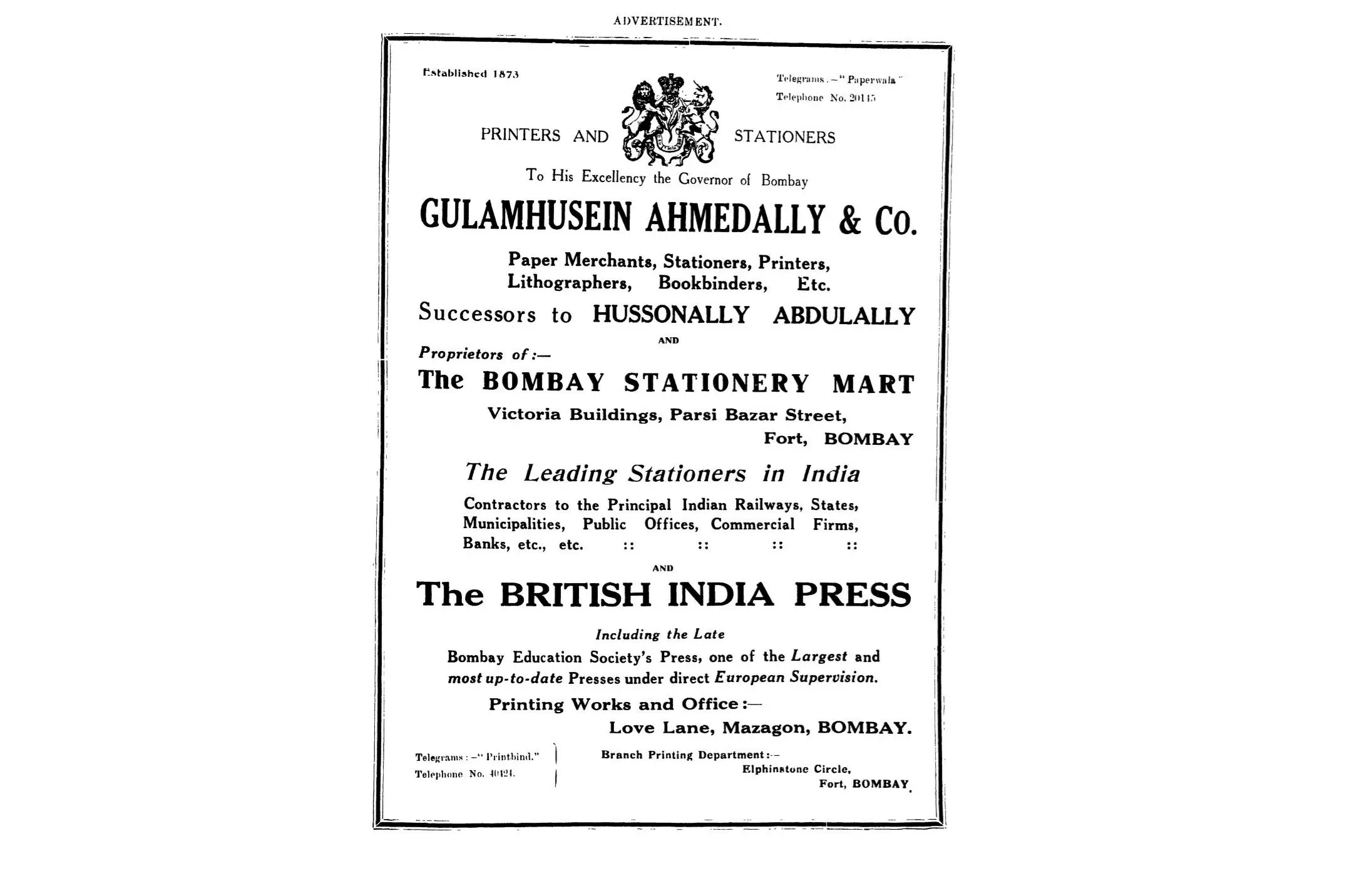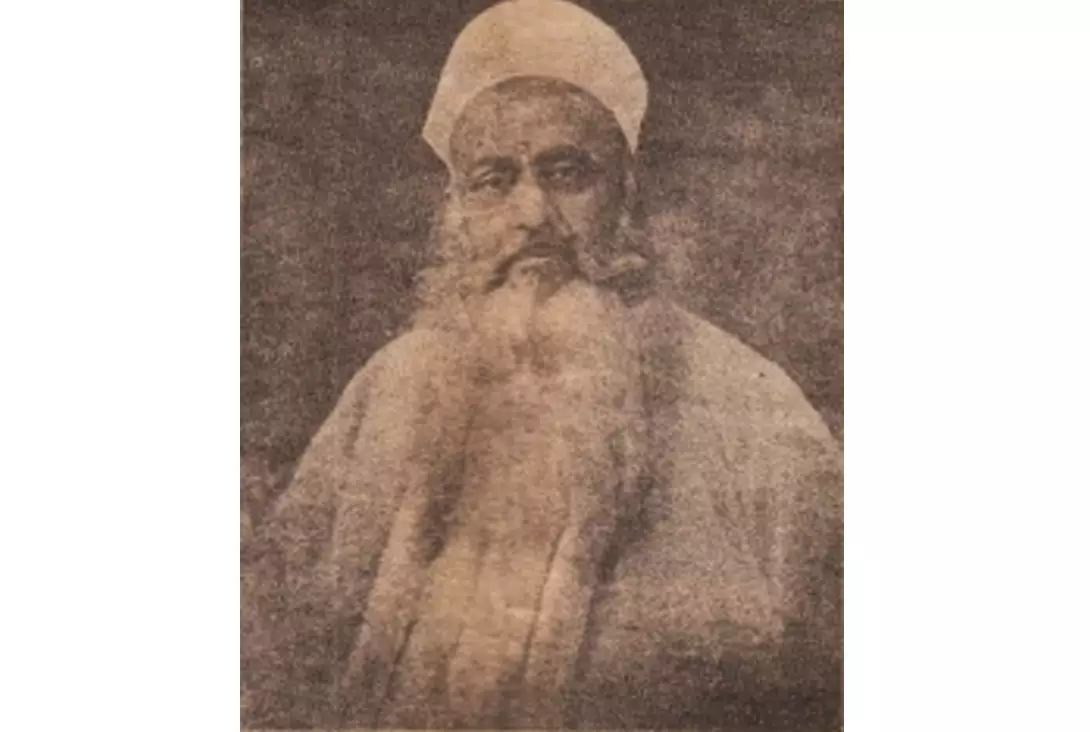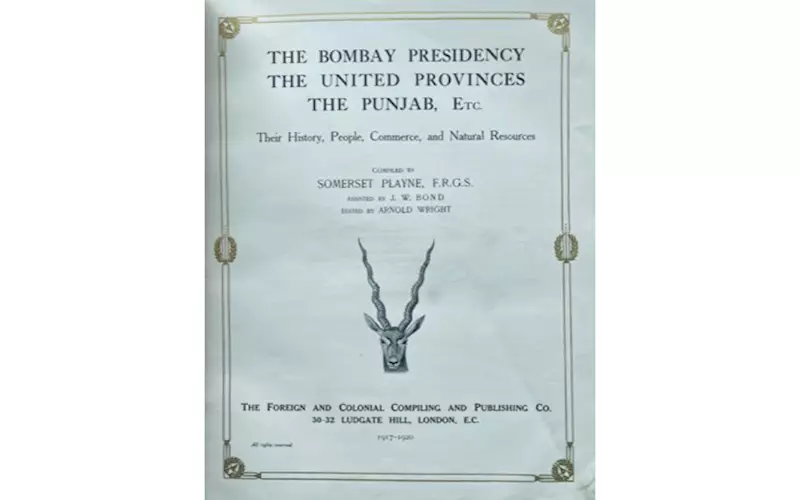Print History: Print behemoth in colonial Bombay - British India Press
How did one man single-handedly build a paper-to-print conglomerate, the largest in colonial Bombay, by the end of the First World War? The career of Hussonally Abdoolally provides the answers
31 May 2022 | By Murali Ranganathan
Somerset Playne (1875–1944), traveller and writer, had been employed by the Lloyd’s Greater Britain Publishing Company from 1900 to travel to Africa and help produce content for its series of books under the general title, Twentieth Century Impressions. However, after a few years, Playne decided to venture into publishing himself and founded the The Foreign and Colonial Compiling and Publishing Company in 1908. The publications of Foreign and Colonial were closely modelled on Twentieth Century Impressions. According to Playne, the main purpose of these books was to “arouse in the English-speaking peoples an intelligent and enduring interest in the King’s dominions and colonies beyond the seas, and at the same time to give such an accurate picture of each section of the Empire as shall make them standard works of reference for all who desire a fuller knowledge of the enormous resources and commercial possibilities of each colony.”
After having published three books on Africa and one on New Zealand, Playne turned his attention to India where he arrived in 1913. The start of the First World War in 1914 meant that he was marooned in India until it ended. Since his erstwhile employer, the Lloyd’s Greater Britain Publishing Company, wound up its operations at around the same time, Playne could avail the services of its editor, Arnold Wright for his company. India was a vast arena and afforded enough material for four books. The first book to appear was Southern India: Its History, People, Commerce, and Industrial Resources (1914) followed by Bengal And Assam, Behar And Orissa (1917). Yet another book was to be issued in the same year, but the exigencies of the First World War prevented its publication. Titled The Bombay Presidency, the United Provinces, the Punjab, etc. : their history, people, commerce and natural resources, it was eventually published in 1920. This hotchpotch agglomeration of provinces reflected the accident of empire. The city of Bombay naturally predominates the book and accounts for over one-third of its nine hundred pages.
If a contemporary chronicler like Playne had to project the industrial and commercial prowess of the city of Bombay in the second decade of the twentieth century, he could choose from a wide range of businesses. There were textile mills in practically every neighbourhood of Bombay, heavy industries fabricating industrial components and machinery dotted the eastern coastline of the city, large banking corporations had their headquarters in the central business district, and the docks which connected the city to the rest of the world was buzzing with the activity of a large number of shipping companies. Bombay was also the capital of printing in India with numerous print establishments, large and small. If the chronicler had to profile just one print establishment in his book, the choice would automatically have been the British India Press. And this is what Somerset Playne chose to do.

Advertisement for Bombay Stationery Mart, The Times of India Calendar and Directory for 1907
Starting from scratch
Very little is known about Hussonally Abdoolally Nasiruddin Dholkawala, the founder of the British India Press. He was probably born in the 1850s at Dholka, a small town near Ahmedabad in Gujarat with a long history and a number of impressive monuments. Hussonally belonged to the Dawoodi Bohra community, a sect of Shia Muslims based largely in Gujarat. As a child, he must have accompanied his family to Bombay in search of a livelihood like so many others of his generation. Family lore has it that he worked in a series of odd jobs and acquired an education, including a knowledge of English, on the streets of Bombay. Hussonally seems to have developed an expertise in trading goods and commodities and building relationships with his clients.
His success led him to establish the Bombay Stationery Mart in 1875 when he was in his thirties. Though India had a vibrant tradition of papermaking which was still thriving in the nineteenth century, most of the paper used for printing was imported. The Bombay Stationery Mart, based in Parsi Bazaar Street in the Fort of Bombay, mainly had institutional customers: large organizations like the Bombay Port Trust and the railway companies, many Indian princely states, leading commercial establishments of the city, and the colonial government itself. Most orders were secured by tender. Though the competition was intense, especially from fellow Dawoodi Bohras, Hussonally seems to have been able to hold his own. He imported paper from all the major manufacturing centres in Europe. For example, in 1896, he imported “seven cases writing paper from Antwerp” (Bombay Gazette 29 August 1896) and in 1899, “eleven bales printing paper from London” (Bombay Gazette 3 March 1899).
Though he focussed on stationery, Hussonally also continued to trade in other goods, supplying them to the same clients to whom he sold paper. For example, for most of the 1880s and 1890s, he was one of the suppliers of provisions, coconut and castor oil to the Bombay Port Trust (Bombay Gazette 8 December 1898). However, as the years went by, his business became synonymous with paper and print. The American journal Office Appliances (January 1910) noted that, “The chief stationery house in Bombay owned by a native firm is that of Hussonally Abdoolally & Co., who are known throughout India, their contracts including many of the railways and large users.” Many of these contracts also included printed items and Hussonally found it necessary to get them printed elsewhere. Eventually in 1900, Hussonally formally entered the printing business which he named the British India Press. Playne notes that:
This printing press was established by Mr. Hussonally Abdoolally in the year 1900 in premises near the Elphinstone Circle, opposite the well-known Bombay Stationery Mart, of which he is also the Proprietor, and its inception was due to the fact that he found his stationery contracts included printed forms and books, and that as a consequence a printing department had become indispensable. From small beginnings the business increased from year to year, and in the early part of 1905, it was decided to take over an adjoining building and fit it with new machinery and the latest styles of British and American types, and in the same year, a thoroughly trained English printer was appointed to superintend the practical working of the press.

Posters printed at British India Press, c. 1920S
Becoming a printer
The turn of the twentieth century was a rough period for print in Bombay. Not only did old print establishments have to keep pace with the hectic global developments in print technology with new investments, they also had to contend with the depredations of the bubonic plague which raged in the city for twenty years from 1896 to 1915. Many of the older printing presses ceased operations or were sold to more dynamic businessmen.
The biggest name in printing in Bombay was the Bombay Education Society’s Press at Byculla. Founded in 1848, its byline appears in every other imprint printed in Bombay from 1850 to the early 1900s. In 1904, it was described by Inland Printer (September 1904), as “one of the largest private presses in India if not the largest. The press which undertakes all classes of jobbing work exceptional facilities for executing letterpress and lithographic printing, bookbinding, engraving, type-founding, electrotyping, and all allied branches of the trade.
The establishment is under European management and about seven hundred hands the majority of whom are of India of the more intelligent type. The entire profits of the press are devoted to the support education of the orphan boys and girls in the society’s schools.” However, running such a big establishment in very competitive times was proving to be a strain for the trustees of the Bombay Education Society and they were eager to find a buyer for their printing operations. Hussonally Abdoolally seized this opportunity and bought this press and incorporated it into the British Indian Press in 1908, thus transforming his business into the largest printing and paper business in western India.
The incorporation of this, the oldest and one of the largest presses for general printing in the Bombay Presidency, together with its machinery and material, furnished additional scope for the execution of large orders in the vernacular as well as in English educational works, but during reorganization it was apparent that, owing to the several departments being located in separate buildings, the premises were not adapted for modern requirements. A suitable site of 1,50,000 square feet was subsequently secured in a central position in Love Lane, Mazagon, at a very reasonable price. … The same economical principle and foresight for future expansion was applied in erecting suitable modern works for carrying on a large printing business under the best conditions, and the spacious buildings being well lighted and ventilated, and all departments furnished with labour and time-saving appliances, form valuable assets in securing contracts for various classes of printing.
As he did not have any sons who survived into adulthood, Hussonally Abdoolally was assisted in his sprawling business by his two sons-in-law, Ahmedally Mulla Khanally and Ahmedally Abedin Madraswalla. His grandson and heir, Gulam Husein Ahmedally, also joined the business at an early age. By 1917, when Somerset Playne (or his Bombay representative) visited the British India Press at Mazagon, its facilities were world-class:
The British India Press may be described as “self-contained,” that is to say, all the processes allied to letter-press printing are executed on the premises, and they include lithography, engraving, copperplate printing, die-stamping, book-binding, account-book making, stereo-typing, and type-casting, in addition to a fitter’s shop for repairing machinery. In the letterpress department, printing is done for railways, shipping companies, and banks; school-books are prepared for publishing firms; and vernacular printing is executed in fourteen languages. Lithographic work consists of the production of bank cheques, debenture forms, maps, plans, wall calendars, mill labels, and a large variety of colour printing. In the bookbinding department, which is one of the largest in India, there are to be seen huge bank ledgers, a splendid selection of account books, and educational works in all kinds of bindings, from the cheap cloth back to the full morocco extra gilt.
The press employs about one thousand workmen in the various departments, all of which are under the able management of Mr. B. Miller, a practical printer of wide experience, and it may be added that this gentleman spares no pains to do everything in his power calculated to further the interests of the proprietor. The proprietor’s financial readiness to maintain the establishment in a state of efficiency by the addition of new machinery, and by the adoption of modern methods of printing and binding, has raised the press to its present successful position. Consideration for the personal well-being of the employees is shown by the daily attendance of a medical man at the works for the purpose of administering preventive and curative medicines to those who require treatment.
The output of the press was prodigious. Besides the legacy jobs from the Bombay Education Society’s Press like the prestigious journal Indian Antiquary, it could grow due to its ability to print in numerous Indian languages. From mundane jobs like printing forms and ruling paper to richly illustrated books and posters, the imprints of the British India Press were recognized for their quality.

Advertisement for British India Press, Thackers Indian Directory, 1925
The man and his legacy
By virtue of his personal traits and extensive business connections in Bombay and elsewhere, Hussonally Abdoolally was recognized as a member of the upper echelons of society. Playne sketches his personality in the following words:
The founder of the British India Press is entitled to regard himself as a notable factor in the commercial progress of the city of Bombay, and the above record may claim to be a contribution to industrial enterprise in India. Mr. Hussonally Abdoolally, who is a Justice of the Peace, and one of the leading citizens of Bombay, is a public-spirited man, and is held in high esteem for his broad, liberal views and philanthropic principles, while his simple and unostentatious mode of living and his courteous manner endear him to all who come in contact with him.
A devout Muslim, Hussonally Abdoolally founded charities both in Mumbai and his native Dholka. He constructed mosques and his endowments funded hospitals and educational institutions. He acquired real estate in Santa Cruz in suburban Mumbai where two streets – First and Second Hassnabad Lanes – are named after Hussonally Abdoolally.

Hussonally Abdoolally
When Hussonally died in 1920, “the business of Paper Merchants, Stationers, Printers, Lithographers, Account Book Manufactures, Hardware Merchants and Contractor, together with the lands, hereditaments and premises where my printing works known as the British India Printing Works are carried on,” was sold, as stipulated in his will, at purchase price to his grandson Gulam Husein Ahmedally, who continued to run the business until his death in the 1940s. The printing works were then sold to the Leader Press Ltd and were being managed by N E Chinwalla in 1944. It seems to have been operational until the 1980s. The family retained the stationery business, Bombay Stationery Mart, which became a city landmark until its closure in the 1990s. Like many other printing firms in Mumbai which had a legacy going back to the nineteenth century, the British India Press could not keep pace with the rapid changes in the print environment. And like them, it failed to protect nearly hundred years of print history and heritage. If any attempt had been made to preserve its records and its heritage machinery, they would have constituted the core of a Mumbai print history museum.
Sources
- The Bombay Presidency, the United Provinces, the Punjab, etc. : their history, people, commerce and natural resources. Compiled by Somerset Playne and edited by Arnold Wright. London: The Foreign and Colonial Compiling and Publishing Company, 1917–1920.
- hussonally.wordpress.com
- Santa Cruz That Was. Teresa Albuquerque. Mumbai, 1981.











 See All
See All